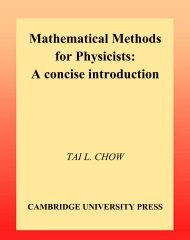The Comprehensive LaTeX Symbol List
The Comprehensive LaTeX Symbol List
The Comprehensive LaTeX Symbol List
Create successful ePaper yourself
Turn your PDF publications into a flip-book with our unique Google optimized e-Paper software.
character as a text character. And the fourth column lists the L A TEX 2ε command to typeset the character<br />
within a \texttt{. . .} command (or, more generally, when \ttfamily is in effect).<br />
Table 125: L A TEX 2ε ASCII Table<br />
Dec Hex Char Body text \texttt<br />
33 21 ! ! !<br />
34 22 " \textquotedbl "<br />
35 23 # \# \#<br />
36 24 $ \$ \$<br />
37 25 % \% \%<br />
38 26 & \& \&<br />
39 27 ’ ’ ’<br />
40 28 ( ( (<br />
41 29 ) ) )<br />
42 2A * * *<br />
43 2B + + +<br />
44 2C , , ,<br />
45 2D - - -<br />
46 2E . . .<br />
47 2F / / /<br />
48 30 0 0 0<br />
49 31 1 1 1<br />
50<br />
.<br />
.<br />
32<br />
.<br />
.<br />
2<br />
.<br />
.<br />
2<br />
.<br />
.<br />
2<br />
.<br />
.<br />
57 39 9 9 9<br />
58 3A : : :<br />
59 3B ; ; ;<br />
60 3C < \textless <<br />
61 3D = = =<br />
Dec Hex Char Body text \texttt<br />
62 3E > \textgreater ><br />
63 3F ? ? ?<br />
64 40 @ @ @<br />
65 41 A A A<br />
66 42 B B B<br />
67<br />
.<br />
43<br />
.<br />
C<br />
.<br />
C<br />
.<br />
C<br />
.<br />
90 5A Z Z Z<br />
91 5B [ [ [<br />
92 5C \ \textbackslash \char‘\\<br />
93 5D ] ] ]<br />
94 5E ˆ \^{} \^{}<br />
95 5F \_ \char‘\_<br />
96 60 ‘ ‘ ‘<br />
97 61 a a a<br />
98 62 b b b<br />
99<br />
.<br />
63<br />
.<br />
c<br />
.<br />
c<br />
.<br />
c<br />
.<br />
122 7A z z z<br />
123 7B { \{ \char‘\{<br />
124 7C | \textbar |<br />
125 7D } \} \char‘\}<br />
126 7E ˜ \~{} \~{}<br />
<strong>The</strong> following are some additional notes about the contents of Table 125:<br />
\textquotedbl is not available in the OT1 font encoding.<br />
ˆ <strong>The</strong> characters “”, and “|” do work as expected in math mode, although they produce, respectively,<br />
“¡”, “¿”, and “—” in text mode. 4 Hence, $$, and $|$ serve as a terser alternative to \textless,<br />
\textgreater, and \textbar. Note that for typesetting metavariables, many people prefer \textlangle<br />
and \textrangle to \textless and \textgreater, i.e., “〈filename〉” instead of “”.<br />
ˆ <strong>The</strong> various \char commands within \texttt are necessary only in the OT1 font encoding. Using other<br />
encodings (e.g., T1), commands such as \{, \}, \_, and \textbackslash all work properly.<br />
ˆ \textasciicircum can be used instead of \^{}, and \textasciitilde can be used instead of \~{}.<br />
For typesetting tildes in URLs and Unix filenames, some people prefer \sim (see Table 29 on page 14),<br />
which produces a larger symbol. But if you don’t mind the tilde produced by \~{}, you should use the<br />
url package to typeset URLs—it has a number of additional nice features.<br />
ˆ <strong>The</strong> IBM version of ASCII characters 1 to 31 can be typeset using the ascii package. See Table 76 on<br />
page 25.<br />
ˆ To replace ‘ and ’ with the more computer-like (and more visibly distinct) ` and ' within a verbatim<br />
environment, use the upquote package. Outside of verbatim, you can use \char18 and \char13 to get<br />
the modified quote characters. (<strong>The</strong> former is actually a grave accent.)<br />
4 Donald Knuth didn’t think such symbols were important outside of mathematics, so he omitted them from the OT1 font<br />
encoding.<br />
39
















